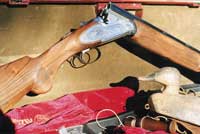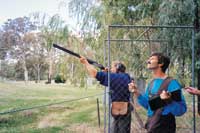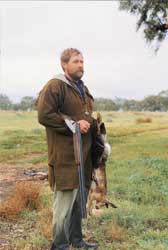Rizzini’s Artemis - a classical field gun from Italy
by John Peek
Australian Shooter September 2000
The Italians know as much about making guns as they do about sports cars - and that’s plenty. When they put their mind to it they are at the forefront of design and taste.


 A new gun in this household is cause for some excitement. A clapped out Stevens Favourite was the last purchase I made and then a very old four-ten double for the glory box. Good guns for the kids, I thought, and I can have the fun of getting them in to real shooting order.
A new gun in this household is cause for some excitement. A clapped out Stevens Favourite was the last purchase I made and then a very old four-ten double for the glory box. Good guns for the kids, I thought, and I can have the fun of getting them in to real shooting order.
But a brand-spanking new gun to play with? Last gun I bought new was the gun that Mr Howard stole. I bought that nearly 30 years ago. So you can see why I felt like a six-year-old on Christmas Eve when I got the box that contained a brand-new Rizzini Artemis over and under. This was going to be fun!
Since the buy-back, we have seen a lot more double guns imported into this country. We are all familiar with the big brand names that have carved a name in shotgun circles in this country. The Rizzini has not been a common gun for a great many years here. So, who is Rizzini?
Rizzini is a major gun manufacturer from the famed Val Trompia region of Italy. This area is a nucleus of the Italian gun-making industry and has been making fine guns there since guns were invented. The Italians know about as much about making guns as they do about sports cars - and that’s plenty. When they put their mind to it they are at the forefront of design and taste. The Rizzini Artemis is no exception. Named after the ancient Greek god of hunting, this gun has classical style and appeal.
There are several Rizzinis making fine guns in this region of Italy and they include Filli, Emilio, Batista and Isidoro. Each firm specialises in a field, from completely hand-made side-by-sides for Europe’s elite to over and unders and double rifles. The Artemis is by Batista Rizzini who specialises in nothing else but over and unders. It is common for many Italian manufacturers to assemble guns from parts bought from smaller specialist companies. This leads to a number of brands that are essentially the same. Not so Batista! His guns are designed, made and tested in-house.
The gun arrived in a velvet-lined case that was injection moulded with a single combination latch and two non-locking latches. Sturdy and, I would imagine, airline proof. Wrapped in velvet barrel and stock sleeves, it came with five chokes: full, improved modified, modified, improved cylinder and cylinder. All chokes are marked so that they can be identified from the muzzle and fit flush internally. Lovely. A solid choke wrench is provided. Other accessories included snap caps, oil and a stock removal tool. Some cleaning brushes and a rod might have been nice.
Being primarily a field gun, it is likely that duck will be a target for the Rizzini owner at some stage. Yes, the barrels and chokes are clearly marked as compatible for steel shot. Chambers are 70mm or standard, which is just fine. I have never felt the need for a three-inch gun and, if I did, I would buy a heavy gun specifically for that purpose. The barrels are monobloc construction, which means that the barrels are fitted into a solid steel block that forms the receiver. On the Rizzini, the ejector and springs are housed in the monobloc and not the fore-end, which should make for a strong fore-end. The fore-end has a positive push-rod catch, which latched firmly in place. The rib is a standard width with a heavy gold bead. It is anchored via six robust points along the barrel.
The action is a fairly standard single trigger box lock. The barrels pivot on side trunions that are reinforced by the front of the action, making for a solid and strong lock up. These trunions could also be replaced should they show signs of wear after many years of use. The trunions are set low, allowing for a medium slim profile. Barrels lock via a large bite on the underside of the barrels. The Artemis has false sideplates to enhance the appeal of the gun. The side plates are well fitted and nicely engraved with a game scene and scroll work. This is very tastefully done and the black cock and grouse featured are pleasing to the eye rather than appearing like fugitives from a chicken yard as seen on some guns. Why sideplates? Same reason as fancy wheels on a Ferrari - why not!
The action features auto ejectors, top tang safety with built-in selectors. The safety is generous but unobtrusive. It is heavily chequered and has a thumb step. This is great. When I used a pump gun for everything, I never used a safety but kept the action cracked. Now I always use it on my double guns and I hate slippery catches that a cold wet thumb can slide off. If I am going to sit out in a winter storm I don’t want that hard-earned shot lost because my thumb did not get the safety off smoothly. The safety is not automatic. Good. The shooter should have enough brains to know when he wants the safety engaged and this is standard for nearly all guns.
I did find that it was fairly easy to accidentally move the barrel selector catch over when opening the gun. At first I thought it was a gun fault but after anticipating it to happen, I realised it was my style of opening the breech that was causing me to knock it over. This may never happen to you and it didn’t happen again once I realised how it occurred.
The trigger is the single selective inertia type. Again, this is today’s standard practice but I greatly favour a double trigger gun for fieldwork. In hunting, the unexpected is to be expected and if you are in a panic and throw in a cracker for a hurried shot at a wounded bird or whatever you may get the wrong barrel. In a rush it is easier to fling one into the top barrel. With a mechanical trigger you can pull it twice, with double triggers just pull the other one, but inertia triggers you must move the selector or get a dull click. A small point and just about every modern gun manufacturer doesn’t seem to agree with me, as there are not many quality double trigger guns on the market, but there you are.
For target work, which I think is what the Artemis will see most, the trigger was just fine. Well contoured with a good pressure. I didn’t notice the trigger in firing, which is just how it should be. Incidentally, Rizzini does make a couple of double trigger guns, which would be well worth a look by the serious shotgun hunter.
The European walnut stock is attached via a single bolt and is easily removed. You may want another stock for a smaller family member perhaps. It makes maintenance easy if you suffer the misfortune of dunking your gun. The wood in this gun was very nice, well figured in a flat oil finish. If I owned this gun I would rub in absolutely minute amounts of suitable wood oil to build up the finish, as I would be using the gun in harsher conditions than most. The semi-pistol grip is the ‘Prince of Wales’ type and nicely chequered, deep and well cut. The fitting of the sideplate is excellent. The buttplate is a nice piece of contrasting wood. It’s a bit pointless to discuss stock fit, as no two shooters are alike, however, I didn’t notice undue recoil with the Rizzini and I wasn’t nursing a bruised cheek, which I often am with many guns.
The Artemis is a handsome gun. It is a nice medium weight, which makes it suitable for the one-gun owner who wants a good, handsome, general-purpose gun. The chokes make it versatile in the extreme and you could happily shoot anything from skeet and quail to high duck with equal confidence. A nice stroll in the hills found the Artemis and I getting along just fine, especially after a couple of hares and a nice fine blackie in the bag. I really don’t want to give it back.
